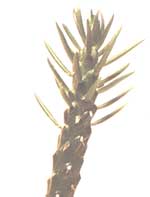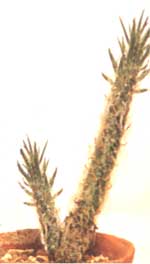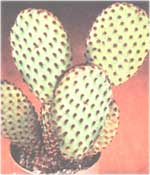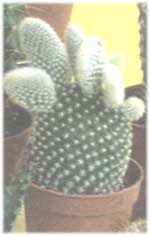Prickly pear / opuntia
Refers to the family of cacti.
General description: Common features for all types of prickly pears are: very small thorns (glochidia), which remain on the hands or clothing with accidental touch, causing a healthy itching; Flowering at a very mature age, when reaching an impressive size. Most of the species are rather cumbersome, so in flats they grow mainly compact forms.
The most popular prickly pears:
Opuntia microdasys (Opuntia small-horned) own articulate flat stems of oval form. Glochidia are bundles of golden hooked hairs. The flowers are large, yellow in color. The species Opuntia microdasys albinospina (Opuntia small-horned white-bellied) owns the advantage that its snow-white glochidia does not fall apart from touching. This species of prickly pear does not grow above 35 cm.
Opuntia cilindrica (Opuntia cilindrica). Its cylindrical stem is not characteristic of prickly pears. Hastily grows and achieves more than 1, 5 m. Flowers are large, pink.
Opuntia bergeriana (Opuntia Bergera) owns long yellow thorns, but it is appreciated for its beautiful flowering .
Recommendations for plant care Opuntia:
Illumination : Photophilous, prefer southern windows, but in the spring should be carefully accustomed to direct sunlight, in order to avoid burns.
Irrigation mode : Moderate, by the measure of drying of the soil. In the winter, outlandish.
Humidity of air : Periodic spraying with warm water from a shallow atomizer is desirable, but the prickly pear is not exacting to the humidity of the atmosphere.
For the summer it is better to place on a fresh atmosphere (in the park or on the balcony). In winter, the dry essence.
Temperature regime : In summer the temperature should be moderate, in winter it is cool, 7-10 ° C, not lower than 5 ° C
Soil : Drainage is mandatory. You can add charcoal and brick chips.
Recommended soil mix: 1 share of sod, 1 share of leaf, 1 share of peat land and 1 share of sand.
During the growth period, it needs fertilizing once every two weeks with fertilizers for cacti and succulents.
Breeding : Seeds, stem cuttings (separate segments) in spring and summer.
Transplantation : In the spring, young plants annually, mature once in a couple of years.
Pests : It is affected by scarlet spider mites (in a dry atmosphere, leaves and stems are braided with cobwebs).
For the prevention of the plant is recommended to wipe with medical alcohol.
With a slight infection, the plant is allowed to help finish with a soap solution and a warm wash.
In case of severe damage, spraying with an insecticide solution (acticle, decis, phytoverm etc.) is recommended.





Prickly pear cilindrica
Prickly pear dressed - opuntia vestita
Opuntia reddish-red - opuntia rufida
Prickly pear cactus - opuntia phaeacantha
Prickly pear cacti - opuntia microdasys albinospina


Comments
When commenting on, remember that the content and tone of your message can hurt the feelings of real people, show respect and tolerance to your interlocutors even if you do not share their opinion, your behavior in the conditions of freedom of expression and anonymity provided by the Internet, changes Not only virtual, but also the real world. All comments are hidden from the index, spam is controlled.